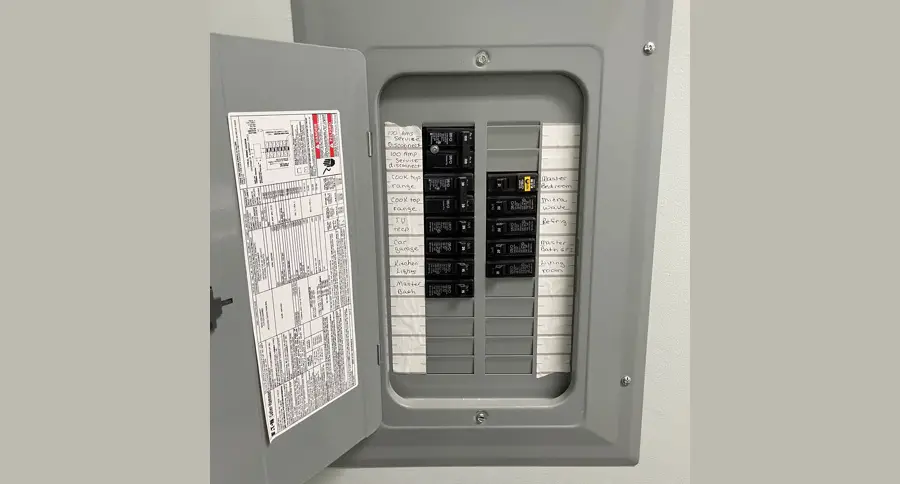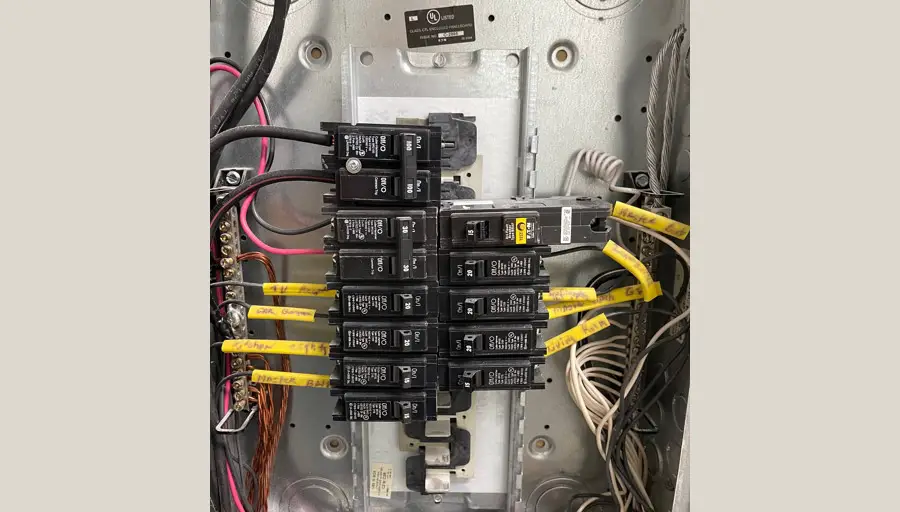
Most contemporary homes have what is now commonly referred to as an electrical panel or the service panel. This service panel acts as the first point of contact beyond the main meter where a power disconnect is triggered and the point where the neutral ground bond occurs.
A 100 amp panel installation is similar to a 200 amp panel, and therefore, the procedure followed during installation is similar. If a 100 amp panel is a subpanel, the panel will have isolated ground and neutrals with the bonding strap removed. For any electrical works around your home, it is always best to seek the services of an electrician, especially when installing service boards.
In comparison, the only minor difference between a 100 amp and the 200 amp panels could probably be the sizing of the main circuit breakers and the thickness of the wire cables used to connect the meter box to the breaker box.
Installing A 100 Amp Service Panel
A 100 amp circuit breaker is enough to power a condo or, to be more precise, a two-bedroomed apartment.
For larger homes with a 200 amp breaker box or higher that need more voltage, you can add a 100 amp subpanel.
Wire sizes are identified in American Wire Guage (AWG) and contain copper or aluminum wires in a wide array of thicknesses.
A 100 amp subpanel installation requires #4 AWG copper wire or an equivalent of #2 AWG aluminum wires. Aluminum is often used for service entry wires because it’s much cheaper than copper, lightweight, and easy to work with despite copper being a better conductor.
To add a breaker sub panel to a service panel, the electrician should install the 100 amp main breaker across two breaker slots. If there is none available, the electrician could pigtail the branch circuit wires and breakers to provide the extra space. An electrician can accomplish this by adding 2-pole individual breakers or tandem breakers to allow two circuits to share a single 110v breaker slot safely.
His job is to configure the route the cables will take toward the breaker sub-panel. He will also need to strip off the ends of the necessary wires to facilitate a proper and secured connection before connecting the cables to the subpanel terminals and the main breaker, ensuring the connection is complete.
Service Panel
When we talk of an electrical service panel, two things come up;
- The Main Panel, which is the main disconnect breaker, 100 amps in this case is the Service Panel.
- The Distribution Panel is the circuit breaker panel with the entire circuit load that may be inside, possibly in the garage.
In older homes, you may find the main service disconnect and the breaker together. Today, most builders install the main disconnect outside (the main panel) and the distribution panel (subpanel) inside the house or garage.
Often, you will find a single circuit breaker at the meter, which is the main breaker (service disconnect), and one or more remote distribution subpanels inside the house.
Depending on the electrical panel installation, you may find the main service panel and disconnect circuit breaker either on the top or bottom, depending on whether the service wire feeds from overhead or underground. It is always good to know that the main service panel has the main disconnect.
Also, the main service panel is bonded. A subpanel is not bonded but has two hot wires, one neutral wire, and a bare copper wire for grounding.
Therefore, a service panel is the distribution point that connects the incoming main service wires (service drop) to the exit wires(branch wire circuits), which branch off to distribute electricity to different parts of the house.
Note that a circuit breaker panel is not the same as a fuse box because it has mechanical, toggle-switch individual circuit breakers, not fuses, but it does perform the same function just in a safer manner.
The older fuses pull in and out instead of the rocker-style installing and removing circuit breakers.
An electrical service panel composes of the following;
- A swinging hinged door providing access to the switches.
- Protective cover giving access to the technical part of the panel.
- Two cables that receive power coming in from the outside
- Extra Circuit Breaker
- Open or shut spaces for extra circuit breakers (optional).
- Assortment of wires that run from the circuit breakers to the circuits that service areas of the house.
The building owner owns the electric service panel in single-family residences, not the electric company. Thus, the owner is responsible for all the electric service panel issues.
As a homeowner, understanding the basics of your home’s electrical service panel will keep you safe and your home well-lit and energized.
You will even save money since operating an electrical service panel is crucial to every electrical repair, from replacing an outlet to wiring an entire room for remodeling.

Distribution Panel And Its Dynamics
It is essential to understand the wiring technique and the required wire gauge to wire a 100 amp service panel successfully.
Safety is paramount and takes the front seat when doing any electrical work on your home.
If you should install too small wires to safely handle the load on large lines that, for example, carry 100 amps, they will routinely overheat and may start a fire.
Mistakes of this nature could turn deadly, so you must use the correct gauge wire before carrying out any electrical work of this nature.
Sub Panels
100 AMP Wire Size is a three-wire cable consisting of three insulated conductors and a bare copper ground wire. In most homes, you will only see a 100 amp service on secondary service panels, which are often called “sub-panels.”
Many homes also have a master service panel that feeds from the municipal hookups and one or more secondary panels fed by the master panel.
Wiring
What gauge wire to use majorly depends on the distance the wire is supposed to cover.
Electrical wires have resistance which eats up current. Longer wires have more resistance simply because they are longer and need to draw more power from the source so that enough power to make it to the outlets.
Advice: If you plan to run your cable 20 feet or more, you may want to consider moving up to 1/0 4-wire.
The cable must have a wire gauge sufficient to the amperage of the subpanel. The cable must also have one or two hot wires depending on your needs, one neutral wire, and one ground wire.
When it comes to a 100 amp line, and you find yourself in the margin between two gauge sizes, err on the side of caution.
Caution
When carrying out electrical work, especially on a service panel, always shut off the power first. You may need to call your power company or obtain an electrical permit if you don’t have a main service disconnect present.
After completing any electrical work involving 100 amp size wire, always arrange for an inspection by a licensed electrician. If you had to obtain an electrical permit, you would need to call the building inspector to pass the work to restore utilities.
Related Questions
- For a 100 amp sub panel, what is the advisable ground wire size to use?
For a 100 amp sub feeder, the associated ground wire needs to be an 8 AWG Copper or 6AWG aluminum wire.
- Is it possible to install a 100 amp subpanel on a 100 amp Service Panel?
Yes, you can safely run a 100 amp sub-panel on a 100 amp main panel because the total could be up to twice the amperage of the box, meaning you could run a subpanel of up to 200 amps.
What’s important is that the subpanel is connecting safely to the main panel and not overloading the service panel.
- Can grounds and neutrals be connected in a subpanel?
It would be best only to connect ground and neutral wires at the last point of disconnect, which happens to be on the main panels only, not on the subpanel.
- Can I run a 100 amp sub-panel on 200 amps main?
You can add the 100 amp breaker to your 200 amp as long as it is not overloaded. However, to start adding the subpanel, you must first calculate how many feet it will be from the main panel to the subpanel.
- Should a sub-panel have a grounding rod?
All subpanels in separate buildings require at least one, and sometimes two, grounding electrodes. Only ensure to refer to the local code requirements.
- Why do grounds and neutrals have to be separated in a sub-panel?
Suppose grounds and neutral wires connect at a sub-panel. In that case, they will not have separate paths back to the service board, meaning you will have current on the grounding conductor posing a danger to anyone working on the circuit.
Conclusion
It is not safe working on an open electrical service panel with both the door and the protective cover removed.
Unlike the shock from a receptacle, which may or may not be fatal, a shock from the service lugs will most certainly be fatal or cause severe damage.
In the service panel, two protruding heavy black wires access the panel from the top of the box. These are the ends of the service wires that come into your house from outside bearing heavy voltage. Avoid any contact with these wires or anything touching these wires by all means.







